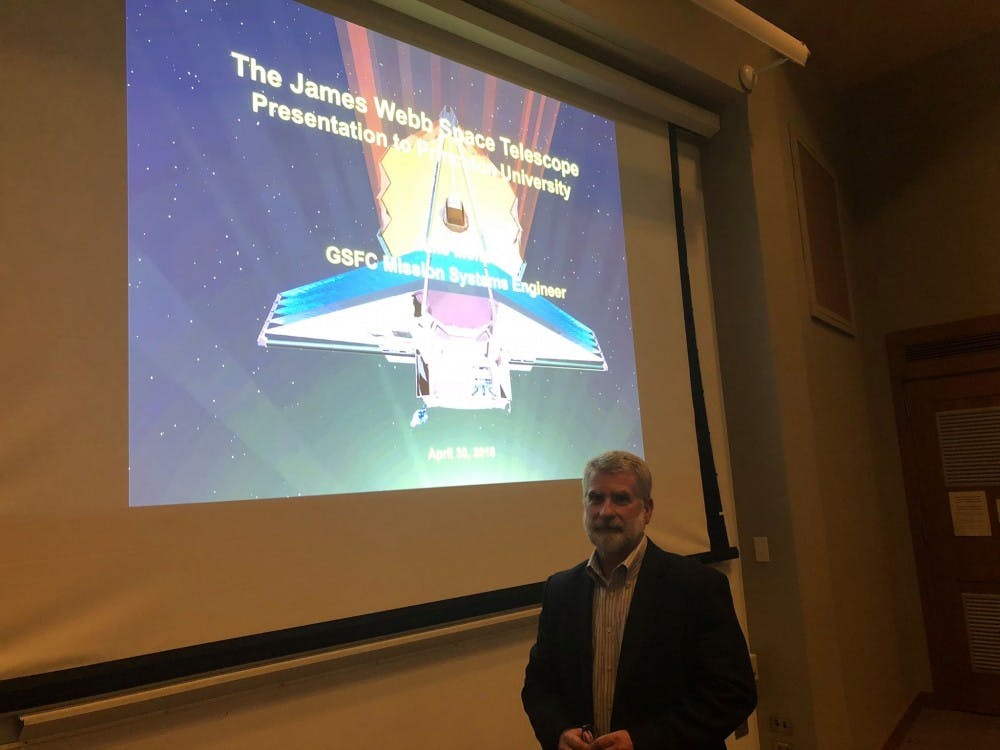On Monday, April 30, Mike Menzel, the Mission Systems Engineer at NASA’s Goddard Space Flight Center, talked about his work on the James Webb Space Telescope (JWST).
“The James Webb Space Telescope is a successor to Hubble; it’s the next great space telescope that NASA will build,” said Menzel, who has worked on the telescope for the past 20 years. “It will be, when it launches in mid-2020, the largest telescope ever put into space. It is being done so in conjunction with the European and Canadian Space Agencies.”
Menzel has 38 years of experience in the space world and has worked as Deputy Program Manager for the Hubble Space Telescope.
Menzel began by paying homage to Hubble, which has been operating in space for 28 years. Launched in 1990, Hubble is a 2.4-meter telescope that works in visible and ultraviolet light, has had five successful servicing missions, and houses eleven unique science instruments, according to Menzel.
The Hubble telescope has also produced iconic images of astronomical events and structures. The telescope has taken high resolution images of star-forming regions and protoplanetary disks, the first images of an exoplanet, and ultra deep field image of our universe.
Menzel described how he viewed the project as a systems engineer, taking the audience through each step of the process. These steps included figuring out the science objective, formulating mission requirements, designing and analyzing the system, taking risk management, technology development, and leading a verification effort into account.
He started with the scientific goals of the project, explaining how he had to talk to different astronomers to figure out what they wanted the JWST to be able to do. These goals include observing stars and galaxies that have been around since the Big Bang and understanding how planetary systems evolve. A more recent goal that was added to the project is the discovery of new exoplanets, including those that may sustain life.
“It was very fortunate that what we designed JWST to [do] could also help us to study the 15,000 or so exoplanets that have been discovered,” Menzel said. “In particular, many of us, or at least myself, hope that James Webb may arguably be capable of detecting some biomarkers on these planets.”
These biomarkers are differences in dips of wavelength that appear when a planet passes in front of a star, and could be indicative of an atmosphere around the planet.
Menzel said that, moving forward, it is necessary to move on from gathering information about the scientific goals of the mission.
He went on to describe the four major types of requirements that need to be considered, which include spectral coverage, radiometric sensitivity, field of regard, and finally resolution and image quality.
Finally, he described the system design of JWST, which takes into account that James Webb needs to be an infrared telescope that works in cryogenic conditions.

“To make it less noisy than our own solar system, James Webb has to be 50K or below,” Menzel said, explaining why the cryogenic conditions are necessary. “If I really want to build a big telescope, making it big is [only] part of it.”
Much of the construction and testing has already been completed.
“The James Webb Space Telescope will be one of the premier astronomical tools of the next decade,” Menzel said. “It has the potential to address some of the most fundamental questions before us.”
The mission is required to last for five years, but the telescope is built to last for 10 years, with hopes that it may last as long as 20 years.
“JWST will re-write the books on astronomy and engineering of future space observatories,” Menzel said. “I consider myself very lucky to be a part of this team and this program, and to have the pleasure of sharing our work with you.”
The talk “The James Webb Space Telescope,” which was hosted by the Mechanical and Aerospace Engineering department, was held on Monday, April 30 at 7:30 p.m. in room 105 of the Computer Science building.








